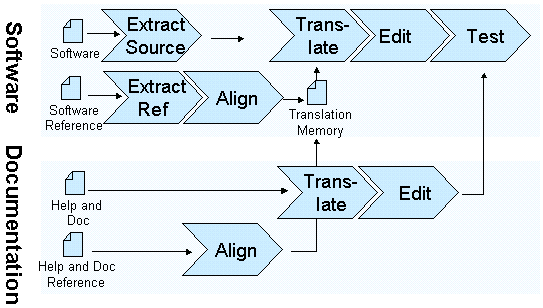Localization
Localization is the process of adapting your product for use in
a foreign market. Successful localization yields a high quality
native tongue translation and retains the functionality of the product.
Localization must also consider how various cultural conventions
in the target country require implementing source code changes.
Underestimation
Can you imagine how a bad translation can damage your product or
brand image? Consider the following example:
|
Practice recommended by Sun is application sucked MVC model.
MVC model View Controller means. The model are the data of application
(e.g. product, customer, orders etc.), Views are opinions of these
data (e.g. product lists, price lists, goods baskets etc..).
|
|
Critical Resources
Another common mistake is to underestimate the financial resources
and the management attention necessary to pursue a successful localization
project. Localization is expensive because it involves the manual
work of highly paid professionals. In addition, these professionals
are distributed across the globe because only native speakers can
deliver reasonable language quality.
The high cost of localization requires a series of optimization
measures such as the preservation of translations from the last
software release and the avoidance of repeated text fragments. Also,
a translator-friendly presentation of your localizable items will
save substantial localization cost, at the prices of an increased
software development effort on the client side.
The Localization Process
The Figure below shows a brief overview over the linguistic processes
that take place in a typical software localization project.

Basically there are four inputs to this process:
- The current software release to be translated
- The current documentation and Help files
- The last software release that has been translated before
- The last documentation and help files that have been translated
before
The translation process takes as a base the translation of the
last software release and integrates this translation into the translation
memory. This way only new or changed items need to be translated,
saving time and preserving a consistent terminology.
A project is usually divided in four phases:
1. Preparation Tasks:
- Creation of a project schedule
- Setup of the project team
- Analysis of the product and terminology
research
- Pre-Production planning
- Glossary development
2. Linguistic and Translation Tasks:
- Translation of software strings
- Translation of Online Help
- Online Documentation
- Tutorials
- Demos
- Printed Documentation
- Incorporating target language screen captures
- Disk labels
- Packaging
- Add-ons
3. Engineering Tasks:
- Extraction of text strings from the software
- DTP layouting of the translated documentation because of text
swell
- Dialog box resizing because of text
swell
- Adaptation of accelerator keys, tooltips, tab order, menu options,
buttons
- Adaptation of sorting orders in list boxes
- Compiling of the help files using help authoring tools
- Localization of multimedia files and embedded graphics containing
text
- Re-creation of sound effects containing text
4. Testing Tasks:
- Consistency checks against localized software
- User Interface Testing
- Functional Testing
- Cosmetic Testing
|

